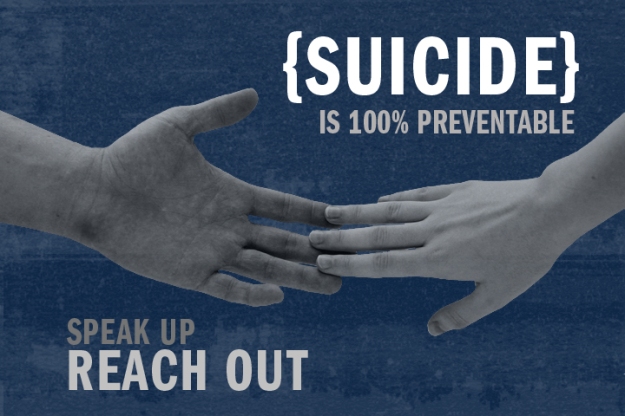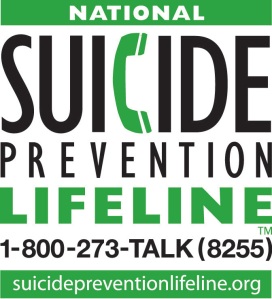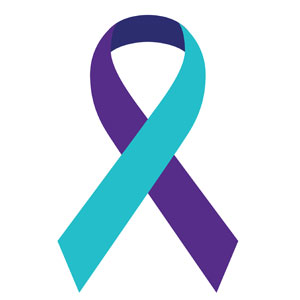Today, September 10, 2014, is World Suicide Prevention Day (WSPD). Rates of suicide are rising. In 2010, suicide was the 10th leading cause of death for all ages. In 2007, suicide was the 11th leading cause of death for all ages. In 25-34 year olds suicide is the 2nd leading cause of death and among 15-24 year olds it’s the 3rd leading cause of death (CDC).

Mental illness doesn’t discriminate. In 2012, 4.1 percent of all U.S. adults 18 years and older had a serious mental illness. That’s 9.6 million adults and does not account for the many children and teenagers who also have a mental illness. And yet, our culture stigmatizes mental illnesses.
I am saddened by the recent apparent suicide of Robin Williams. That someone who provided so much laughter and joy to people also experienced such depths of despair is tragic. It’s devastating that his struggle with mental illness and addiction ended with him taking his own life. That he was in such a dark place that he desired death, is heartbreaking. But I can understand that desire.
For myself, that desire to die is fleeting but it can be so strong. Had I not been found and taken to an ER in time as a teenager, I’d be dead. And I immediately regretted the action afterwards. But, even knowing that experience, there have still been moments of struggle and fighting to stay alive. I don’t think our culture talks enough or at all about this struggle. And I don’t think I’m the only one who has felt that way. But the more we don’t talk about it, the more we stigmatize it, and honestly we are losing people because of our lack of discussion on the topic.
So I’m sharing part of my struggle with you all. Because mental illness isn’t something that happens somewhere else. It happens to people you know, your schoolmates, your coworkers, your family, your friends, your neighbors. How many struggle in silence? If you’re struggling with some tough emotions or feeling lonely, don’t hesitate to reach out for help. You can call the Lifeline at 1-800-273-TALK (8255).

Risk factors for suicide (characteristics that make it more likely that an individual will consider, attempt or die by suicide) include:
- Mental disorders, particularly mood disorders, schizophrenia, anxiety disorders and certain personality disorders
- Alcohol and other substance use disorders
- Hopelessness
- Impulsive and/or aggressive tendencies
- History of trauma or abuse
- Major physical illnesses
- Previous suicide attempt
- Family history of suicide
- Job or financial loss
- Loss of relationship
- Easy access to lethal means
- Local clusters of suicide
- Lack of social support and sense of isolation
- Stigma associated with asking for help
- Lack of health care, especially mental health and substance abuse treatment
- Cultural and religious beliefs, such as the belief that suicide is a noble resolution of a personal dilemma
- Exposure to others who have died by suicide (in real life or via the media and Internet)
Warning signs of suicide (may mean that someone is at risk for suicide) include:
- Talking about wanting to die or to kill themselves.
- Looking for a way to kill themselves, such as searching online or buying a gun
- Talking about feeling hopeless or having no reason to live.
- Talking about feeling trapped or in unbearable pain.
- Talking about being a burden to others.
- Increasing the use of alcohol or drugs.
- Acting anxious or agitated; behaving recklessly.
- Sleeping too little or too much.
- Withdrawing or isolating themselves.
- Showing rage or talking about seeking revenge.
- Displaying extreme mood swings.

If you, or someone you care about is struggling, feeling stuck, hopeless or disconnected, there are ways to get help and support. The Suicide Prevention Lifeline is available 24/7 by calling1-800-273-TALK (8255).
The National Suicide Prevention Lifeline has also created a partnership with Facebook to make crisis services more easily assessable to those in need. If a Facebook friend posts something that causes you to worry that they may harm themselves, you can now report suicidal content on Facebook. The person who posted the suicidal comment will then immediately receive an e-mail from Facebook encouraging them to call the National Suicide Prevention Lifeline or to click on a link to begin a confidential chat session with a crisis worker.

The purple and turquoise Suicide Prevention Ribbon symbolizes suicide awareness and prevention and serves as a reminder that suicide is an issue we need to talk about. Download a ribbon avatar and make it your profile picture on Facebook and Twitter during National Suicide Prevention Week (September 9-15). Awareness ribbons can be found HERE.
Even in the darkest, most desolate moments, YOU matter. Please, please know that there is always help and support.










